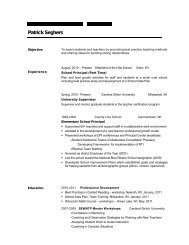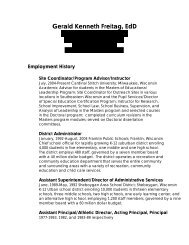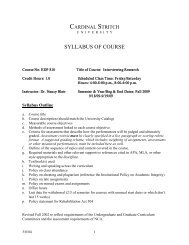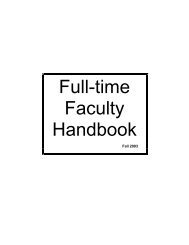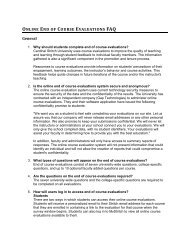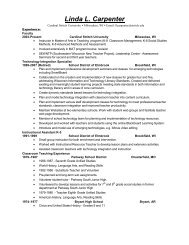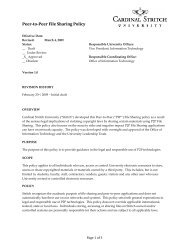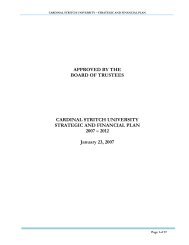EN 201 Syllabus - Cardinal Stritch University
EN 201 Syllabus - Cardinal Stritch University
EN 201 Syllabus - Cardinal Stritch University
Create successful ePaper yourself
Turn your PDF publications into a flip-book with our unique Google optimized e-Paper software.
CARDINAL STRITCHU N I V E R S I T YSYLLABUS OF COURSECourse No: <strong>EN</strong><strong>201</strong>Title of Course: Configuration of FamiliesCredit Hours: 3 Scheduled Class Time: Mon 5:00-8:35 Hours:Instructor: Sarah Foust Vinson Semester: Spring Year: <strong>201</strong>3<strong>Syllabus</strong> Outline: The following information must be included in each syllabus ofcourse.a. Course titleb. Course description (should match the current <strong>Cardinal</strong> <strong>Stritch</strong> <strong>University</strong> Catalog)c. Program Learning Outcomes linked to the course (only note those that are achieved in the specific course)d. Measurable Course Learning Outcomes and Performance Indicatorse. Explain how course is in compliance with <strong>University</strong> policy on Credit Hour.f. Methods of assessment linked to each Course Learning Outcome.g. Criteria for assessment that describe how the performances (Performance Indicators) will be judged andultimately graded. Assessment criteria must be clearly specified in a list, paragraph or scoring rubricformat. A suggested grading scheme, which includes weighting of assignments, assessments or othermeasured performances, must be included here as well.h. Outline of the sequence of topics and content covered in the course.i. Required materials and other relevant supportive references cited in APA, MLA, or other style appropriateto the discipline.j. Textbook(s) usedk. Policy on class attendancel. Policy on cheating and plagiarism (reference the <strong>University</strong> Policy on Academic Integrity in the current<strong>University</strong> catalog at www.stritch.edu/catalogs )m. Policy on late assignmentsn. Policy on missed exams and assignmentso. Office hoursp. Last date for withdrawal (2/3 of semester for courses with unusual start dates or which don’t last 15 weeks)q. Policy statement for Rehabilitation Act 504: It shall be the policy of <strong>Cardinal</strong> <strong>Stritch</strong> <strong>University</strong> tocomply with the Rehabilitation Act and Americans with Disabilities Act and their regulations to theextent applicable to <strong>Cardinal</strong> <strong>Stritch</strong> <strong>University</strong>.r. If this course requires LiveText, please include the following statement: “This course requires an activesubscription to LiveText. A five-year LiveText subscription must be purchased online atwww.livetext.com. Click on Purchase/Register at the top of the LiveText homepage. If you have alreadypurchased a LiveText subscription for a different course, you do not need to purchase it again.”1
CARDINAL STRITCHU N I V E R S I T Y<strong>EN</strong> <strong>201</strong>: Configuration of FamiliesSpring <strong>201</strong>3Mondays 5:00 p.m.-8:35 p.m.Instructor: Sarah Foust Vinson, Ph.D.Office Hours: Monday and Wednesday 1:00-2:00 and Friday 11:00-1:00 and by appointmentOffice: Main Campus, Bonaventure Hall 2109Phone Number: 414-410-4537 (work); 773-860-6471 (cell)E-mail: skfoustvinson@stritch.eduCourse Description, <strong>EN</strong> <strong>201</strong>, 3 Credit Hours:This course will examine the ways in which literature reflects human relationships, which in turn allows us toreflect on our own culturally-shaped conceptions of love and family. Content and pedagogy will be integratedby providing participants with an opportunity to develop and use literary analysis as a means of understandingculture and connecting to literature. This course is taken concurrently with ECUE 291 and 398 and MT 105.Measurable Literature Program Course Outcomes1. Understand terminology, cultural and historical contexts, and genres2. Perform close reading, analyzing and interpreting ideas3. Prepare persuasive arguments that demonstrate cohesiveness and critical thinking, incorporate primaryand secondary sources, and use appropriate citation strategies4. Make connections between key artists and styles5. Consider others’ perspectives on ideas in texts<strong>EN</strong> <strong>201</strong> Course ObjectivesStudents will:1. Examine and describe your understanding of the relationship among language, culture, and literacy.[Relates to Program Outcomes 1, 4, and 5]2. Recognize and understand the terminology, forms and techniques involved in three distinct genres asthey analyze both verbally and in writing [relates to Literature Outcome 1]3. Develop close reading skills [relates to Literature Outcome 2]4. Strengthen your understanding of the connections between reading, writing, and thinking through aprocess approach. [Relates to Literature Outcome 2 and 5]5. Construct a well-supported argument about issues connected to the concept of family. [Relates toLiterature Outcomes 2 and 3]3
Grading/Major AssignmentsAssignment Breakdown: Total Possible Points: 100• Quizzes regarding definitions and usage of literary terms. [Assesses Course Objective 2]30 points• Writing about Poetry reflection. [Assesses Course Objective 3, 4, and 5]20 points• Oral presentation of literary work. [Assesses Course Objective 1 and 3]10 points• Literary Argument Essay. [Assesses Course Objectives 2, 3, 4, and 5]40 pointsYour final semester grade will be determined by the following scale:Final grade is based on cumulative points earned. Total Possible Points: 100.100-93 = A 82-81 = B- 70-68 = D+92-91 = A- 80-78 = C+ 67-63 = D90-88 = B+ 77-73 = C 62-61 = D-87-83 = B 72-71 = C- Below 61 = FAssignment Detail• Quizzes: Literary terms and definitions: Sessions 4, 8, and 11You will complete three in-class quizzes to assess your understanding of key terms from each unit.Your first quiz during session 4 will include literary terms, definitions, and examples from our poetryunit. Your second quiz during session 8 will include terms and examples from our unit on short stories.Your third quiz during session 11 will include terms and examples from our unit on drama. Eachsubmission will be worth 10 points, for a total of 30 possible points. Your grade will depend on theaccuracy of your responses.• “Writing about Poetry” response: Final draft due to Angel: 3/11Review the first two prompts in the “Writing about issues” section of page 436 in our course text:--Pick one of the seven preceding poems, and argue that it offers an appropriate view ofgrandparents.--Pick two of these poems, and argue that something of value is argued in each.Choose one and write a two to three page response.Note that these prompts call for argument, so you will need to consider this as you write. Your purposewill be to persuade. It will help to imagine an audience for your response. Your response shouldinclude textual examples in the form of quotes and paraphrasing. These will be used to support youroverall argument. Your response should have an introductory paragraph, including a strongargumentative thesis statement, at least three persuasive body paragraphs containing sub-arguments(clearly stated as topic sentences) and supporting evidence, and a conclusion. Your response should bebetween two to three pages in length, double-spaced, and use APA conventions. See attached rubric.4
• Literary Argument Essay: Final draft due to Angel: 5/17In this assignment, you will demonstrate your ability to read closely, to analyze literature, and toconstruct an argument. You will also incorporate terms and concepts from the course text todemonstrate understanding of content.In the introduction to an anthology of literature, the authors quote Frank Lentriccia, who says, “When itis the real thing, literature enlarges us, strips the film of familiarity from the world, creates bonds ofsympathy with all kinds, even with evil characters, who we learn are all in the family” (8). Consider theliterature about families and relationships that we have read this semester. Choose one short story thatyou feel best exemplifies the ideas contained in the quote above. Write an argument about how theauthor’s use of particular literary elements, which are described in chapter five of our text, “enlarges us,strips the film of familiarity from the world, creates bonds of sympathy with all kinds,” and perhapsteaches us something about our own humanity. You will need to envision an audience for yourargument and employ persuasive strategies, as described in chapter three of our text. See “Writing aboutPoetry” assignment for additional tips about the organization of your essay. Your essay should bebetween four to five pages in length, double-spaced, and use APA conventions. See attached rubric.• Oral Presentation of Literary WorkEach student will be assigned a literary work from among the readings we will be doing for class. Eachstudent will be responsible for facilitating class discussion on his or her assigned text on the day that itwill be discussed. Please limit presentation to five minutes and leave time (approx. 15 minutes) forquestions and discussion. You will provide a brief introduction to the context of the work (time inhistory, surrounding events that may have had an impact on the author, biographical information aboutthe author, and anything else that may be relevant to our understanding of how to make connectionsbetween what we read and issues of culture, language, and literacy. You will also be responsible forpreparing careful notes to guide our discussion, as well as for providing three to five discussionquestions for us to consider. See attached rubricRequired TextsSchilb, J. and Clifford J., Eds. (<strong>201</strong>1). Making literature matter, 5 th edition. Boston: Bedford.General Course Expectations1. Attend all class sessions.2. Come to class prepared to participate actively in class activities and discussions.3. Arrive to class on time.4. Submit all assignments on time.5. Type all assignments unless otherwise noted, using APA guidelines.Class AttendanceEmergency absences require a telephone call or email to the instructor in advance of the class meeting time.The student is responsible for contacting a “study buddy” for assignments/handouts and the instructor for makeupassignments. Unexcused absences or more than one excused absence will negatively affect course grade.Based on program policy, missing more than two classes in this course can result in a withdrawal. Thiswithdrawal will need to be processed through the registration office. Three tardies or early departureswill be equal to one absence.5
Late WorkAny late or missing assignments inevitably affect the final grade. Late assignments will be lowered one gradeper day. Assignments may be submitted through Angel or e-mailed in the case of an absence to avoid a latepenalty.Plagiarism and Academic IntegrityPlagiarism is an extremely serious offense. Plagiarism is the use, intentional or unintentional, of anotherperson’s words or ideas. A plagiarized paper is one in which passages are summarized, paraphrased, or quotedverbatim from another person's writing without proper acknowledgment. A paper that has been written inwhole or in part by one person and that is submitted under the name of another person is also guilty ofplagiarism. Plagiarism also includes failing to provide proper documentation, handing in a paper from aprevious class, engaging in sloppy paraphrasing, pulling a paper off the web, using parts of a paper pulled offthe web, etc. If you plagiarize another’s work, you will get a 0 (zero) on the paper in which the infractionappears and may face disciplinary action from the university. Please refer to the Academic Integrity Policy inthe current university catalog at www.stritch.edu/catalogs.Turnitin.comEssays will be submitted through Angel, which, in turn, submits work through turnitin.com. Turnitin willcreate an originality report to ensure the work you submit is not plagiarized, intentionally or unintentionally.Use this feature as a way to check your own work. If you find a problem, please fix it and resubmit before thedeadline.Non-Discrimination/Harassment PolicyIt is the policy of <strong>Cardinal</strong> <strong>Stritch</strong> <strong>University</strong> to foster a community free of discrimination and harassment.Students and employees are expected to conduct themselves in a respectful manner at all times. Incidents ofdiscrimination and harassment will not be tolerated.Harassment is defined as conduct that targets an individual or group to demean, humiliate, intimidate, orridicule. Such conduct can have the intent or effect of interfering with an individual’s performance or creatingan intimidating, hostile, or offensive environment.Harassment includes, but is not limited to: written or verbal insults, jokes, slurs, innuendoes, messages, orimages that are derogatory to members of a particular race, national origin, sexual orientation, or other group;destruction of personal property; spreading rumors with malicious intent; physical harassment; threats; nuisancephone calls; or stalking behaviors. Harassment also includes negative actions based upon a student’s oremployee’s participation in activities identified with any group. In order to promote a non-discriminatory,inclusive environment, <strong>Cardinal</strong> <strong>Stritch</strong> <strong>University</strong> provides programs to educate its community in regard torespect for all its members.Student-to-student or student-to-employee harassment or discrimination incidents are handled through the Codeof Conduct and investigated by the Dean or Assistant of Students. Appropriate corrective action is taken basedon the nature of the incident and the student’s disciplinary history. Disciplinary sanctions can include a writtenor verbal warning, disciplinary probation, mediation, educational assignment, community service, removal fromuniversity housing, suspension, or expulsion.6
Last Day to WithdrawThe last day to withdraw is Friday, April 5 at 5:00 p.m.Academic Support CenterI encourage you to make use of the Academic Support Center, which offers free tutoring services to all <strong>Cardinal</strong><strong>Stritch</strong> <strong>University</strong> students. The Center is located on the first floor of Bonaventure Hall (414-410-4166). Alsoconsider using <strong>Stritch</strong>’s Online Writing Lab at http://library.stritch.edu/OWL/index.html.Assistance for Students with DisabilitiesIf you have any disability or handicap that might affect your class work, please see me immediately. <strong>Cardinal</strong><strong>Stritch</strong> <strong>University</strong> affirms the intent of Federal Law, the Rehabilitation Act of 1973, Section 504. It shall be thepolicy of <strong>Cardinal</strong> <strong>Stritch</strong> <strong>University</strong> to comply with the Rehabilitation Act and Americans with Disabilities Actand their regulations to the extent applicable to <strong>Cardinal</strong> <strong>Stritch</strong> <strong>University</strong>. Any person enrolling in this coursewho may require alternative instruction and/or evaluation procedures due to a handicapped condition shouldfeel free to discuss these needs with me so that appropriate arrangements can be made.Daily Course ScheduleSession Topics Read before class Write before class: In class:Session 11/28What is literature?How to read closelyIntro: pages 1-7, 19.Families: 247. FreewritePages 22-26; 41-48Freewrite: pg. 44 “ASession 22/4Introduction to poetry“How to write about poems,”pgs. 143-145; “The elements ofpoetry,” pgs. 157-167.Make a list of literary termsand definitions to help studyfor your quiz.Writing Exercise.”Freewrite: Choose one ofthe poems on pages 145-152. Using only that poem,complete the ‘WritingExercise’ on page 160.Session 32/11Session 42/18Writing about poetry Grandparents and legacies: p.425.All poetry on pages 425-435Cook-Lynn; Giovanni; Hogan;Soto; Rios; Cervantes; Cofer.Poetry continuedChapter 4: “The writingprocess,” pgs. 75-81.Pg. 425: “before you read”freewrite.Pg. 436: “writing about issues”-pick one and draft a rough draftof an essay. See “writing aboutpoetry” assignment and rubricPoems about fathers: 270-276.Poetry presentations anddiscussionShort answer quiz: termsand definitions frompoetry unit.Girl (pgs. 55-56)Chapter 3: “Strategies formaking arguments aboutliterature,” pgs. 57-69.Peer response/developmentworkshop for poetryresponse7
Session 52/25Introduction to shortstoriesChapter 4: “The writingprocess,” pgs. 82-93.Finish draft of “writing aboutpoetry” response.See RubricPg. 108; The use of force (109-111).Peer response and work onpoetry response, submit draftfor instructor commentsSession 63/11Session 73/18Elements of short stories“The elements of shortfiction,” pgs. 122-133.Two kinds (pgs. 305-314)Everyday use (pgs. 314-322)Short stories continued Sonny’s blues (pgs. 336-360)I stand here ironing (pgs.298-304)Final draft of “writing aboutpoetry” response due.See RubricMake list of literary terms anddefinitions from short story unitto study for quiz.Theme: 133-138; Shortstory presentations anddiscussions.Short Story TermsShort story presentations anddiscussions.Session 83/25Session 94/29Introduction to drama Trifles (pgs. 941-953) Short answer quiz: termsand definitions from shortstories unit.Discuss TriflesFreewrite about Trifles“How to write about plays,”pgs. 168-187.Make a list of literary termsand definitions for drama unitto study for quiz.Drama continued A raisin in the sun (pgs. 443-83).Begin “literary argument”essay. See assignment andrubricWorkshop essay drafts withfocus on thesis statements andoutlinesDiscuss playFilm: A raisin in the sunSession 105/6Session 115/13Drama continued. A raisin in the sun (pgs. 483-513).Review/ Preview (Praxis)*Daily schedule is subject to change based on needs of particular section.Continue revising “literaryargument” essay.See RubricFinal revisions of “literaryargument” essay due forworkshop.See Rubric.Final draft due: 5/17.Discuss playFilm cont.: A raisin in the sunPeer response/conferences foressayShort answer quiz: termsand definitions fromdrama unit.Workshop final essays as aclass.8
Meets expectationsTwo PointsRubric for “Writing about Poetry” responsePartially meets expectationsOne PointIntroduction The argument is clearly contextualized. The introduction provides adequatecontextual detail.Thesis The thesis is complete and effective. The thesis is adequate, but may beeither incomplete or less thaneffective.Body paragraphsQuoting/paraphrasingConclusionWritingAPAEach body paragraph contains a strongsub-argument.Each body paragraph contains a topicsentence.Each body paragraph containssupportive evidence.Evidence from texts is accuratelyquoted or adequately paraphrased insupport of the main argument.A final synthesis ties all of theconnections within the argument.The argument is well written anddesigned with few if any mechanicalerrorsSome of the body paragraphs containstrong sub arguments.Some of the body paragraphs containtopic sentences.Some of the body paragraphs containsupportive evidence.Evidence from texts is sometimesadequately paraphrased and/orsupportive of the main argument.Most, but not all, connections arepresent in the final synthesis.Some mechanical errors exist;however, they do not interfere withmeaning.Does not meetexpectationsNo PointsThe introduction does notcontextualize theargument.The thesis is notcomplete or effective.The body paragraphs donot make clear subarguments.The body paragraphs donot contain topicsentences.The body paragraphs donot contain supportiveevidence.Quotes and paraphrasingare not accurate orsufficient.A final synthesis islacking or veryincomplete.The argument needsserious editing.Argument is well-organized. Argument is fairly well organized. Argument is disorganizedand unclear.APA is accurately referenced in the APA is generally accurate; some APA is inaccurate.paper and on the list of references. inaccuracies are presentTotal possible points: 20Total _____/20 points toward final grade.9
Meets expectationsFour PointsRubric for “Literary Argument” essayPartially meets expectationsTwo PointsIntroduction The argument is clearly contextualized. The introduction provides adequatecontextual detail.Thesis The thesis is complete and effective. The thesis is adequate, but may beeither incomplete or less thaneffective.Body paragraphsQuoting/paraphrasingConclusionWritingAPAEach body paragraph contains a strongsub-argument.Each body paragraph contains a topicsentence.Each body paragraph containssupportive evidence.Evidence from texts is accuratelyquoted or adequately paraphrased insupport of the main argument.A final synthesis ties all of theconnections within the argument.The argument is well written anddesigned with few if any mechanicalerrorsSome of the body paragraphs containstrong sub arguments.Some of the body paragraphs containtopic sentences.Some of the body paragraphs containsupportive evidence.Evidence from texts is sometimesadequately paraphrased and/orsupportive of the main argument.Most, but not all, connections arepresent in the final synthesis.Some mechanical errors exist;however, they do not interfere withmeaning.Does not meetexpectations0 PointsThe introduction does notcontextualize theargument.The thesis is notcomplete or effective.The body paragraphs donot make clear subarguments.The body paragraphs donot contain topicsentences.The body paragraphs donot contain supportiveevidence.Quotes and paraphrasingare not accurate orsufficient.A final synthesis islacking or veryincomplete.The argument needsserious editing.Argument is well-organized. Argument is fairly organized. Argument is disorganizedand unclear.APA is accurately referenced in the APA is generally accurate; some APA is inaccurate.paper and on the list of references. inaccuracies are presentTotal possible points: 40Total _____/40 points toward final grade.10
ClarityOrganizationQuestionsContextPresenterPresenceMeets expectationsTwo PointsThe speaker clearly described thecontents of the presentation.Presentation was well organized;transition points were clearlyindicated.Relevant questions addressedcontent and/or literary concepts.Contextual information wasinformative.The presenter appeared confident,made eye contact, and usedexpression and enthusiasm.Rubric for Oral PresentationPartially meets expectationsOne PointMost parts were clear, however some partscould have profited from more detail orexplanation.Presentation was organized but transitionswere not well marked.Some questions addressed content and/orliterary concepts.Contextual information was adequate.The presenter seemed uncomfortable attimes, occasionally avoided eye contact andseemed to lack enthusiasm or expression.Does not meet expectationsNo PointIt was difficult to follow theexplanation.Presentation lackedorganization.Questions did not sufficientlyaddress content and/or literaryconcepts.Contextual information wasinadequate.The presenter wasconsiderably uncomfortablein front of the audience.Total possible points: 10Total _____/10 points toward final grade.11





